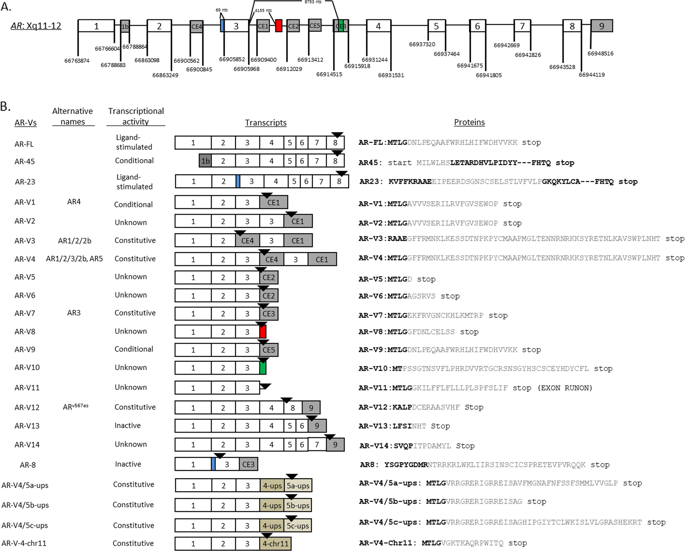Prostate Cancer and Prostatic Diseases ( IF 5.1 ) Pub Date : 2020-03-05 , DOI: 10.1038/s41391-020-0217-3 Changxue Lu 1 , Landon C Brown 2 , Emmanuel S Antonarakis 1, 3 , Andrew J Armstrong 2 , Jun Luo 1, 3

|
Background
The androgen receptor (AR) is a key prostate cancer drug target. Suppression of AR signaling mediated by the full-length AR (AR-FL) is the therapeutic goal of all existing AR-directed therapies. AR-targeting agents impart therapeutic benefit, but lead to AR aberrations that underlie disease progression and therapeutic resistance. Among the AR aberrations specific to castration-resistant prostate cancer (CRPC), AR variants (AR-Vs) have emerged as important indicators of disease progression and therapeutic resistance.
Methods
We conducted a systemic review of the literature focusing on recent laboratory studies on AR-Vs following our last review article published in 2016. Topics ranged from measurement and detection, molecular origin, regulation, genomic function, and preclinical therapeutic targeting of AR-Vs. We provide expert opinions and perspectives on these topics.
Results
Transcript sequences for 22 AR-Vs have been reported in the literature. Different AR-Vs may arise through different mechanisms, and can be regulated by splicing factors and dictated by genomic rearrangements, but a low-androgen environment is a prerequisite for generation of AR-Vs. The unique transcript structures allowed development of in situ and in-solution measurement and detection methods, including mRNA and protein detection, in both tissue and blood specimens. AR-V7 remains the main measurement target and the most extensively characterized AR-V. Although AR-V7 coexists with AR-FL, genomic functions mediated by AR-V7 do not require the presence of AR-FL. The distinct cistromes and transcriptional programs directed by AR-V7 and their coregulators are consistent with genomic features of progressive disease in a low-androgen environment. Preclinical development of AR-V-directed agents currently focuses on suppression of mRNA expression and protein degradation as well as targeting of the amino-terminal domain.
Conclusions
Current literature continues to support AR-Vs as biomarkers and therapeutic targets in prostate cancer. Laboratory investigations reveal both challenges and opportunities in targeting AR-Vs to overcome resistance to current AR-directed therapies.
中文翻译:

雄激素受体变异驱动的前列腺癌II:实验室研究的进展。
背景
雄激素受体(AR)是重要的前列腺癌药物靶标。由全长AR(AR-FL)介导的AR信号传导的抑制是所有现有的AR导向疗法的治疗目标。AR靶向剂可带来治疗益处,但会导致成为疾病进展和治疗抵抗力的AR畸变。在去势抵抗性前列腺癌(CRPC)特有的AR畸变中,AR变体(AR-Vs)已成为疾病进展和治疗耐药性的重要指标。
方法
在我们于2016年发表最后一篇评论文章之后,我们对文献进行了系统性综述,重点是针对AR-Vs的最新实验室研究。主题涉及AR-Vs的测量和检测,分子起源,调控,基因组功能和临床前治疗靶向。我们提供有关这些主题的专家意见和观点。
结果
在文献中已经报道了22种AR-V的转录物序列。不同的AR-V可能通过不同的机制产生,并且可以由剪接因子调节并由基因组重排决定,但是低雄激素环境是产生AR-V的前提。独特的转录物结构允许开发组织和血液标本中的原位和溶液中测量和检测方法,包括mRNA和蛋白质检测。AR-V7仍然是主要的测量目标,也是最广泛使用的AR-V。尽管AR-V7与AR-FL共存,但由AR-V7介导的基因组功能不需要存在AR-FL。AR-V7及其共调节子指导的截然不同的和转录程序与低雄激素环境下进行性疾病的基因组特征一致。
结论
当前文献继续支持AR-Vs作为前列腺癌中的生物标志物和治疗靶标。实验室调查显示,针对AR-V克服现有AR导向疗法的耐药性既面临挑战,也面临机遇。











































 京公网安备 11010802027423号
京公网安备 11010802027423号